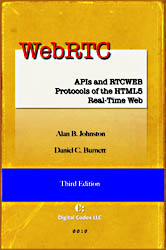When with its first edition Alan Johnston and Dan Burnett committed to continually update their book, WebRTC API and RTCWEB Protocols of the HTML5 Real-Time Web, it felt like exuberance. With the second edition of the book, their promise gained credibility, and with the just-published third edition we see that their commitment is not only solid, but also practical.
For owners of previous editions of Johnston and Burnett’s book, the decision to buy the third edition is easily rooted in the usefulness of new information it has to offer, particularly on such issues as data channels and local media and the ways in which to apply WireShark in debugging code. The third edition has a better flow in terms of descriptive text and the pseudo code used to teach developers how to debug their code, and the authors also added a section on real-time text over the data channel.
For those for whom the third edition of WebRTC API and RTCWEB Protocols of the HTML5 Real-Time Web will be their first copy, the wait can be justified by the weight, but more importantly the support site continues to expand. More importantly, it matches well to the W3C expectations with runnable code, and owning a copy of the third edition provides access not only to a strong foundation of code but supplies a practical way in which to stay up to date with the leaders in WebRTC.
 As Johnston and Burnett point out, WebRTC has a great chance of bringing a level of interoperability with implementations, and for that reason alone anyone looking to use WebRTC should pay attention to the book’s lessons on peer-to-peer communication and the answer/offer negotiation. And the authors say that they expect future editions of WebRTC API and RTCWEB Protocols of the HTML5 Real-Time Web will have even more content around signaling, the data channel, third-party identity verification, and error handling as the standards and industry mature in these areas.
As Johnston and Burnett point out, WebRTC has a great chance of bringing a level of interoperability with implementations, and for that reason alone anyone looking to use WebRTC should pay attention to the book’s lessons on peer-to-peer communication and the answer/offer negotiation. And the authors say that they expect future editions of WebRTC API and RTCWEB Protocols of the HTML5 Real-Time Web will have even more content around signaling, the data channel, third-party identity verification, and error handling as the standards and industry mature in these areas.
The only other book of which I own every edition (it’s now on its fourth) is known by its readers as the BigBook, and while the third edition of WebRTC API and RTCWEB Protocols of the HTML5 Real-Time Web is not quite as thick, it does feel as though the iteration of editions is being done with the same goal. That goal being to better reflect the opportunity, and to enable the reader to say, “Yes I see how this program works and how I can apply it.” All of which makes the expansion of Johnston and Burnett’s work and its supporting website a welcome practical guide to delivering and developing a richer communication experience.
Johnston and Burnett reminded me that they regard their book and website as symbiotic but singular.
“Anyone can try out the demo application and download the code. All the sample code from all editions is available at demo.webrtcbook.com. All aspects of the code, client and server side, are explained in the book. So someone who doesn't fully understand it after trying it out might purchase the book.”
I applaud the efforts of the authors to help WebRTC developers to improve their code, and I unreservedly recommend that if you consider yourself a member of that community that you buy a copy of the third edition of WebRTC API and RTCWEB Protocols of the HTML5 Real-Time Web and improve your library as well.
Edited by
Rachel Ramsey